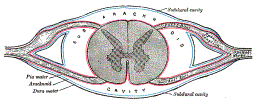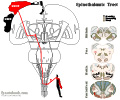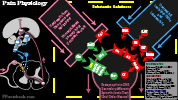Pain Sensation, Pain Physiology, Allodynia, Hyperpathia, Central Sensitization, Nociceptor
- Definitions
- Allodynia
- Nonpainful stimulus results in Perception of pain
- Hyperpathia
- Pain out of proportion to pain stimulus
- See Also
- Anatomy
- Images
- Nociceptors
- Nociceptors, often Free Nerve Endings with specialized channels, detect painful, noxious stimuli
- Thermal pain (>43 C) triggers TRPV1 channels
- Mechanical pain (e.g. pressure, deformation, skin breakage) are detected by polymodal receptors
- Chemical pain (e.g. Capsaicin and other skin irritants, spices, toxins, acids) triggers TRP channels
-
Peripheral Nerves
- Pain signals follow two axonal paths
- A-delta axons (myelinated, faster at 20 m/s, carry immediate severe sharp Sensation)
- C axons (unmyelinated, polymodal, slow at 2 m/s, carry delayed dull, less intense pain)
- Skin Sensation follows Dermatomes
- Carry afferent pain signals back to the spinal cord posterior root (at the posterior horn of the grey matter)
 Lewis (1918) Gray's Anatomy 20th ed (in public domain at Yahoo or BartleBy)
Lewis (1918) Gray's Anatomy 20th ed (in public domain at Yahoo or BartleBy)
- Pain signals follow two axonal paths
-
Spinothalamic Tract (ascending sensory tract, anterior cord)

- Transmits pain and TemperatureSensation (as well as some light Touch Sensation)
- Fibers cross the midline within 1-2 spinal levels of their peripheral Sensory Nerve origin
- Courses to contralateral Thalamus and cerebral cortex (or terminates in Brain Stem)
- Descending Inhibitory Tract
- Hypothalamus releases hormonal signals
- Periaqueductal grey matter and periventricular nucleus (PVN) is chemically triggered by Hypothalamus
- Nucleus raphe magnus (NRM) is triggered by Neuronal signals from PVN
- Interneurons are triggered by NRM serotinergic Neurons
- Interneurons enter the Substantia gelatinosa (SG) in the dorsal horn of the spinal column
- Pathophysiology
- General
- Pain Perception Factors
- Response to Chronic Pain may be learned
- Reaction to pain may be reinforced (patient, family)
- Behavior may persist after pain resolves
- Modulation of Sensation
- First dorsal horn Synapse enhances or inhibits pain
- Modulation occurs in various locations
- Spinothalamic Tract
- Frontal cortex
- Descending inhibitory neuro-systems
- Pain Mechanisms
- Neuropathic pain
- Characteristics: Burning, stabbing or shooting pain
- Examples: Stroke, Radiculopathy
- Musculoskeletal pain or Mechanical compression pain
- Characteristics: Aching, soreness, stiffness
- Examples: Myofascial Pain Syndrome, Fibromyalgia, Low Back Pain
- Inflammatory pain
- Characteristics: Aching, swelling, hot, red
- Examples: Rheumatoid Arthritis, Postoperative pain, Septic Joint
- Neuropathic pain
- Dorsal horn Synapse physiology
- Neurotrasmitters transmitting pain signals from C-polynodal Nociceptor (presynaptic)
- Receptors on post-synaptic membrane of dorsal horn Neuron
- Pathophysiology
- Gate Control Theory
- Specific pain fibers from injured tissues via
- Alpha fibers myelinated
- Delta and C-fibers unmyelinated
- Modulated at spinal cord gate
- Substantia gelatinosa
- Control transmission cells
- Spinothalamic Tract cephalad
- Descending signals (regulate gate at spinal cord)
- Pain transmission can be blocked by emotion or mood
- Sensory discriminative system
- Determines differences in sensory threshold
- Motivational Affective System
- Reciprocal relationship between mood and pain
- Central control processes
- Include unknown processes of pain
- Pathophysiology
- Central Sensitization
- Central Sensitization is an inappropriate response to low level stimuli
- Exaggerated stimulus response, with lower thresholds triggering a pain response
- Pain persists after trigger is removed
- Ascending pain signals are amplified and pain inhibitory signals are suppressed
- Increased Cytokine concentrations after infections
- Sympathetic Nervous System hyperactivity
- Endogenous Opioid system changes
- Altered brain neuroplasticity
- Resources
- Nociceptor (Wikipedia)
- Purves (2001) Neuroscience, 2nd edition. Sunderland, Nociceptors

